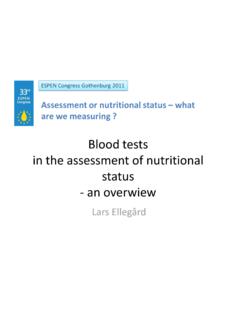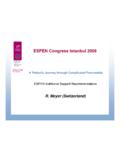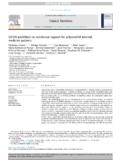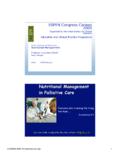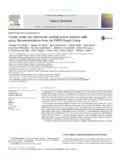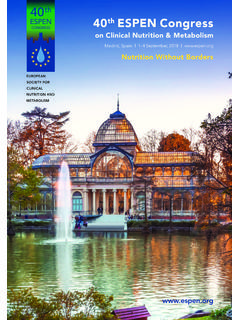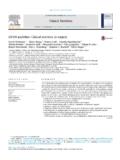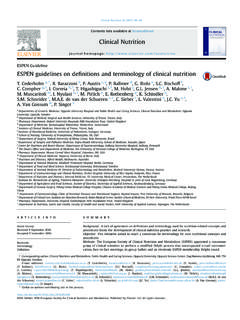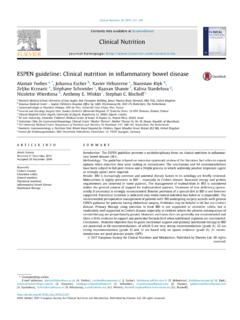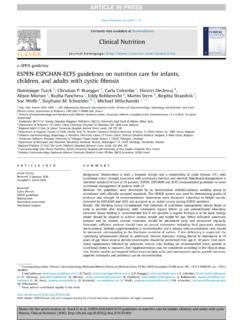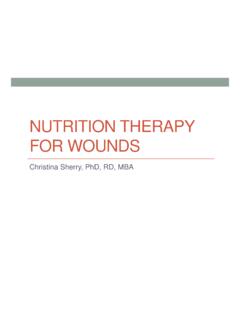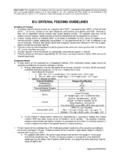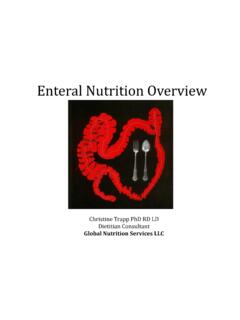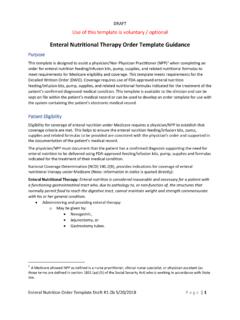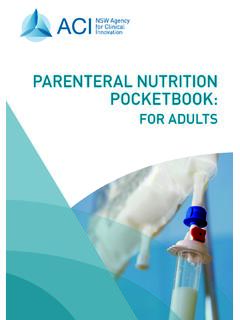Transcription of ESPEN guideline on home enteral nutrition
1 ESPEN GuidelineESPEN guideline on home enteral nutritionStephan C. Bischoffa,*, Peter Austinb,c, Kurt Boeykensd, Michael Chourdakise,Cristina Cuerdaf, Cora Jonkers-Schuitemag, Marek Lichotah, Ibolya Nyulasii,St ephane M. Schneiderj, Zeno Stangak, Loris PironilaUniversity of Hohenheim, Institute of nutritional Medicine, Stuttgart, GermanybPharmacy Department, Oxford University Hospitals NHS Foundation Trust, Oxford, UKcUniversity College London School of Pharmacy, London, UKdAZ Nikolaas Hospital, nutrition Support Team, Sint-Niklaas, BelgiumeSchool of Medicine, Faculty of Health Sciences, Aristotle University of Thessaloniki, Thessaloniki, GreecefHospital General Universitario Gregorio Mara~n on, nutrition Unit, Madrid, SpaingAmsterdam University Medical Center Location AMC, Amsterdam, the NetherlandshIntestinal Failure Patients Association Appetite for Life , Cracow, PolandiDepartment of nutrition , Department of Rehabilitation, nutrition and Sport, Latrobe University.
2 Department of Medicine, Monash University, AustraliajGastroenterology and nutrition , Centre Hospitalier Universitaire, Universit eC^ote d Azur, Nice, FrancekDivision of Diabetes, Endocrinology, nutritional Medicine and Metabolism, Bern University Hospital and University of Bern, SwitzerlandlCenter for Chronic Intestinal Failure, St. Orsola-Malpighi University Hospital, Bologna, Italyarticle infoArticle history:Received 15 April 2019 Accepted 19 April 2019 Keywords:Home enteral nutritionTube feedingNutrition support teamEnteral formulaMonitoringsummaryThis guideline will inform physicians, nurses, dieticians, pharmacists, caregivers and other home enteralnutrition (HEN) providers about the indications and contraindications for HEN, and its implementationand monitoring. Home parenteral nutrition is not included but will be addressed in a separate ESPEN guideline .
3 This guideline will also inform interested patients requiring HEN. The guideline is based oncurrent evidence and expert opinion and consists of 61 recommendations that address the indications forHEN, relevant access devices and their use, the products recommended, the monitoring and criteria fortermination of HEN, and the structural requirements needed to perform HEN. We searched for meta-analyses, systematic reviews and single clinical trials based on clinical questions according to the PICO format. The evidence was evaluated and used to develop clinical recommendations implementing theSIGN method. The guideline was commissioned andfinancially supported by ESPEN and the members ofthe guideline group were selected by ESPEN . 2019 European Society for Clinical nutrition and Metabolism. Published by Elsevier Ltd. All IntroductionSince its introduction in the 1970s, HEN has been established asa reliable and effective nutritional intervention, particularly rele-vant due to the increasing reliance on ambulatory care.
4 Usually HENis started during a hospital stay and continued as a long-term hometherapy. Typically, there are only minor differences in the indicationfor HEN and for in-hospital enteral nutrition (EN). In HEN, addi-tional criteria need to be considered carefully such as prognosis,health-related quality of life (QoL) and any ethical aspect of thetreatments. In order to initiate HEN, the principle should be fol-lowed that without EN there is an expectation of significant dete-rioration of the patient's nutritional state, affecting prognosis andQoL, which is a complex decision, if there is no effective treatmentfor the underlying medical nutrition support is a medical treatment but the de-cisions on route, content, and management of nutritional supportare best made by multidisciplinary nutrition guideline provides evidenced-based information on the useof HEN.
5 There are numerous and often complex diseases that leadto the need for HEN, a description of which is not part of the presentguideline, but they include:Abbreviations:BBS, Buried bumper syndrome; EN, enteral nutrition ; HEN, homeenteral nutrition ; HPN, home parenteral nutrition ; NST, nutrition support team;PEG, percutaneous endoscopic gastrostomy; PEJ, percutaneous endoscopic jeju-nostomy; PRG, percutaneous radiological gastrostomy; QoL, health-related qualityof life; RCT, randomized controlled trial; RIG, radiologically inserted gastrostomy.*Corresponding Bischoff).Contents lists available atScienceDirectClinical Nutritionjournal homepage: 2019 European Society for Clinical nutrition and Metabolism. Published by Elsevier Ltd. All rights nutrition 39 (2020) 5e22 Swallowing disorders because of neurological diseases, Obstructions because of malignancies, Cachexia because of cancer, Chronic obstructive pulmonary disease, Heart disease, Chronic infections, and Malabsorption/maldigestion because of liver, pancreas, or in-testinal specific nutritional requirements for these diseases aredescribed in detail in other recently published ESPEN guidelines(see ESPEN website and Clinical nutrition journal).
6 The presentguideline is focused on the methodology and clinical practice ofHEN, the related monitoring, and strategies to avoid General methodologyThe present guideline was developed according to the standardoperating procedure for ESPEN guidelines[1], and based in part onthe German guideline Artificial nutrition in the outpatient area [2]. The guideline was developed by an expert group representingdifferent professions including physicians (SCB, MC, CC, SMS, ZS), apharmacist (PA), a nurse (KB) and dieticians (MC, IN, CJS), as well asa patient representative (ML).Based on the standard operating procedures for ESPEN guide-lines and consensus papers, thefirst development step of thisguideline was the formulation of so-called PICO questions toaddress specificpatient groups (orproblems),interventions,compare different therapies and beoutcome-related[1].
7 In total,19 PICO questions were created and split intofive main chaptersentitled Indication and contraindication for HEN , Access devicesfor HEN , Products recommended for HEN , Monitoring andtermination of HEN and Structural requirements to performHEN . To answer these PICO questions, a literature search wasperformed to identify suitable meta-analyses, systematic reviewsand primary studies (for details see below, search strategy ). EachPICO question was allocated to subgroups/experts for the differenttopics and 59 recommendations answering the PICO questionswere formulated. The grading system of the Scottish IntercollegiateGuidelines Network (SIGN)[3]was used to grade the literature. Theallocation of studies to the different levels of evidence is shown inTable 1. Supporting the recommendations, the working groupadded commentaries to explain their grades of recommendation were decided according to thelevels of evidence assigned (Table 2).
8 In some cases, a downgradingfrom the generated grades of recommendation was necessarybased on the levels of evidence according toTables 1 and 2, e. g. dueto a lack of quality of primary studies included in a cases are described in the commentaries accompanying therespective recommendations. The wording of the recommenda-tions reflects the grades of recommendations since level A is indi-cated by the use of the word shall , level B by the word should and level 0 by the word can or may . The good practice points(GPP) are based on experts opinions due to the lack of studies, forwhich the choice of wording was not 27th June and 25th July 2018, an online voting on therecommendations was performed using the All ESPEN members were invited to agree or disagreewith the recommendations and to provide comments. Afirst draftof the guideline was also made available to the participants on thatoccasion.
9 Forty-three recommendations reached an agreement>90%,14 recommendations reached an agreement of>75e90% andtwo recommendations an agreement 75%. Thoserecommendations with an agreement higher than 90% (indicating astrong consensus,Table 3) were directly passed, and all others wererevised according to the comments and voted on again during aconsensus conference which took place during the 2018 ESPENC ongress in Madrid on 2nd September 2018. Two recommenda-tions (Recommendations 1 and 53) that originally had receivedmore than 90% agreement were also voted on during the consensusconference due to major changes in wording. At that time, all rec-ommendations except for eight of them received an agreementhigher than 90%. During the consensus conference, two of theoriginal recommendations were split into two separate recom-mendations.
10 Therefore, thefinal guideline comprises of 61 recom-mendations. To support the recommendations and the assignedgrades of recommendation, the ESPEN guideline office createdevidence tables of relevant meta-analyses, systematic reviews and(randomized) controlled trials. These evidence tables are availableonline assupplemental materialto this guideline ( ). Search strategyThe literature search was performed separately for each PICO question in March 2018. The Pubmed, Embase and Cochrane da-tabases were searched using the searchfilters human , adult and English . Some authors included their mother tongue as on the PICO questions, different search terms presentedinTable 4were used in combinationwith enteral nutrition / homeenteral nutrition / tube feeding / home care services / intubation,gastrointestinal / feeding tube placement / PEG / gastrostomy / percutaneous endoscopic gastrostomy / RIG / jejunostomy / PEJ / PEGJ / gastric button / nasogastric intubation / nasogastrictube /naso gastric tube / enteral tube feeding / enteral feedingtube.
